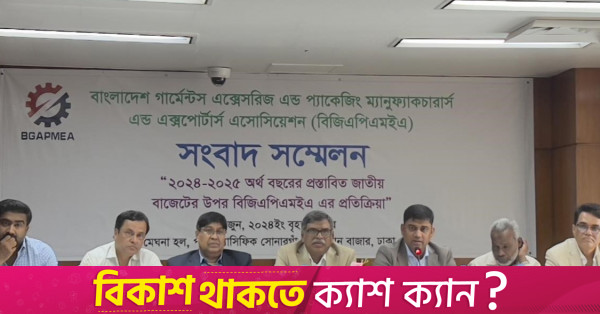RMG accessories makers demand cash incentives from FY25


“If the government introduces it, that will be helpful to export more,” said Al Shahriar Ahmed, president of the association
Members of Bangladesh Garment Accessories and Packaging Manufacturers and Exporters Association at a post-budget press conference in Dhaka on 13 June. Photo: Jasim Uddin/TBS
“>
Members of Bangladesh Garment Accessories and Packaging Manufacturers and Exporters Association at a post-budget press conference in Dhaka on 13 June. Photo: Jasim Uddin/TBS
The Bangladesh Garment Accessories and Packaging Manufacturers and Exporters Association has demanded cash incentives for their contribution to apparel exports starting in the fiscal 2024-25.
“We demand the implementation of cash incentives for the accessories and packaging sectors as deemed exporters. If the government introduces it, that will be helpful to export more,” said Al Shahriar Ahmed, president of the association, during a post-budget press conference at a city hotel on Thursday (13 June).
Shahriar highlighted the significant contributions of the accessories and packaging sectors, which involve direct and deemed exports worth nearly $9 billion.
He noted that the packaging industry alone commands a global market exceeding $700 billion. “We already have the capability to enter the market.”
He emphasised, “We manufacture accessories and packaging for almost all export sectors and have the capacity to meet local demands. Unfortunately, we have yet to receive government attention. We will work with the government to seize this opportunity.”
Speaking with The Business Standard, Abdul Kader Khan, a former president of the association, mentioned that textiles and accessories manufacturers contribute about 60-65% to apparel items, although the specific contribution of the accessories sector is not clearly determined.
“Accessories alone contribute 10% to 20% of an apparel item’s value, depending on the product price range,” he added.
Kader Khan stated that the sector has been urging for incentives for a long time, noting, “If the government provides cash incentives for local clothing, why the contributions of local accessories shouldn’t be recognised?”
Al Shahriar Ahmed urged the implementation of the decision to issue Utilisation Declarations (UD) by the association, similar to other associations related to apparel exports, to facilitate the export activities of the garment accessories and packaging industries.
“We demand that all goods and services for the packaging and accessories sector be exempt from duties and VAT,” he said.
In his written speech, Shahriar demanded a 0.5% source tax for five years instead of the existing 1%, considering this a final settlement.
He also called for the withdrawal of the proposal for a 200-400% penalty in case of an unintentional HS Code mismatch and requested utility connections and bank loans for factories outside industrial zones for five years.
He stated that the proposed budget for the FY25 is not unrealistic but requires business-friendly policy support for implementation. “We demand the withdrawal of all new and increased duties on the export-oriented sector. If the government considers our demands, they can easily implement the budget.”
Shahriar noted that while the finance minister proposed many good policies in the budget proposal, there is confusion about welcoming the budget.
“A tolerable inflation rate provides opportunities for small entrepreneurs to conduct business, creating employment and helping the government earn revenue. However, the proposed budget lacks specific guidelines in this area,” he added.
He also criticised the proposal to increase the regular taxpayer’s rate to 30% while allowing undisclosed and black money holders amnesty by paying just 15% tax, calling it illogical.
Responding to a question, Rafez Alam Chowdhury, also a former president of the association, said, “The private sector is crucial for creating employment. According to a survey by the Bangladesh Bureau of Statistics, over 1 lakh private sector employees have lost their jobs.”
“We directly export over $1.5 billion through the accessories and packaging sector, which is significant compared to the global market size. This market is dominated by China and Vietnam, although we have the capacity to capture a larger share,” he added.



